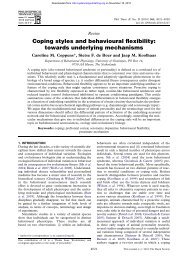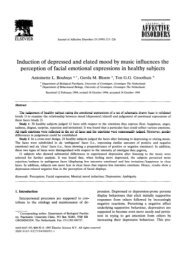Colin Pittendrigh, Jürgen Aschoff, and the Natural Entrainment - CBN
Colin Pittendrigh, Jürgen Aschoff, and the Natural Entrainment - CBN
Colin Pittendrigh, Jürgen Aschoff, and the Natural Entrainment - CBN
Create successful ePaper yourself
Turn your PDF publications into a flip-book with our unique Google optimized e-Paper software.
204 JOURNAL OF BIOLOGICAL RHYTHMS / June 2000<br />
Figure 10. Accuracy of entrainment as a function of phase<br />
response curve <strong>and</strong> τ-response curve amplitude. Based on simulations<br />
in Beersma et al. (1999).<br />
tation, time memory, or <strong>the</strong> precise measurement of<br />
day length—we may view this as a fitness l<strong>and</strong>scape,<br />
in which <strong>the</strong> best adapted systems are found at <strong>the</strong><br />
peak of <strong>the</strong> l<strong>and</strong>scape.<br />
This is early in our analyses. The details of <strong>the</strong> peak<br />
location <strong>and</strong> size will undoubtedly turn out to depend<br />
on exactly how <strong>the</strong> noise, <strong>the</strong> stochastic variation of<br />
light intensity, is structured in <strong>the</strong> natural world. We<br />
are currently exploring a series of more naturalistic<br />
possibilities, which may move <strong>the</strong> accuracy peak to<br />
different combinations of PRC <strong>and</strong> τ-RC amplitude.<br />
For <strong>the</strong> time being, however, it is intriguing <strong>and</strong> gratifying<br />
to note that <strong>the</strong> peak occurs at a relative amplitude<br />
of <strong>the</strong> τ-RC that is about 6 times smaller than that<br />
of <strong>the</strong> PRC. This ratio, of course, corresponds closely<br />
to <strong>the</strong> ratio in measured amplitudes for diurnal mammals<br />
(Beersma et al., 1999). I will return to this issue for<br />
nocturnal mammals shortly.<br />
This “fitness l<strong>and</strong>scape”—if we may consider accuracy<br />
of daily timing as a currency for evolutionary fitness—is<br />
for a non-burrower with continuous access to<br />
light outside. A diurnal burrower can also remain<br />
entrained by letting its τ be modulated even if it sees<br />
only a small <strong>and</strong> erratic part of <strong>the</strong> daily light intensity<br />
curve. Figure 11 gives <strong>the</strong> simulated pattern of light<br />
perceived by an animal that is only above ground from<br />
ct 0 until ct 10. It does remain entrained by virtue of<br />
adjusting its τ to exactly 24 h, in spite of <strong>the</strong> fact that it<br />
Downloaded from<br />
http://jbr.sagepub.com at University of Groningen on July 31, 2009<br />
Figure 11. Simulation of stable entrainment of circadian activity<br />
by combined phase <strong>and</strong> period adjustment in a diurnal burrower<br />
exposing itself from ct 0 to ct 10 to natural variations in light<br />
intensity.<br />
never sees <strong>the</strong> twilight <strong>and</strong> that <strong>the</strong> light signal it<br />
receives is enormously variable.<br />
Finally, we can compare <strong>the</strong> accuracy of entrainment<br />
for <strong>the</strong> three types—non-burrower, diurnal burrower,<br />
<strong>and</strong> nocturnal burrower. So we made two fur<strong>the</strong>r<br />
such 3D l<strong>and</strong>scapes <strong>and</strong> summarized <strong>the</strong><br />
locations of <strong>the</strong> peaks in Figure 12. The solutions turn<br />
out to vary. Maximal accuracy is reached in <strong>the</strong> diurnal<br />
burrower at relatively high values of <strong>the</strong> PRC amplitude<br />
as well as <strong>the</strong> τ-RC amplitude—or at large<br />
<strong>Pittendrigh</strong>s <strong>and</strong> large <strong>Aschoff</strong>s. The optimal solutions<br />
for <strong>the</strong> nocturnal burrower are found at much<br />
smaller τ-RC amplitude. This may provide an adaptive<br />
explanation for <strong>the</strong> fact that <strong>the</strong> τ after effects of<br />
single pulses in nocturnal rodents are probably<br />
smaller—<strong>and</strong> indeed more rarely observed—than in<br />
<strong>the</strong> diurnal species. Also quantitatively <strong>the</strong> solutions<br />
correspond reasonably to our best current estimates of<br />
<strong>the</strong> ratio between phase <strong>and</strong> velocity responses (lines<br />
in Fig. 12). Of more general importance still is that all<br />
three solutions are characterized by <strong>the</strong> fact that during<br />
entrainment, <strong>the</strong> endogenous τ is modulated by<br />
<strong>the</strong> velocity response to exactly 24 h (shaded area in<br />
Fig. 12), <strong>and</strong> thus <strong>the</strong> system no longer requires a net<br />
phase shift each day.





